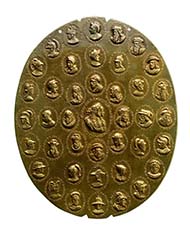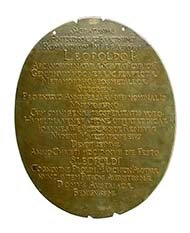by courtesy of the Berlin Coin Cabinet
on the occasion of its exhibit “Gold Giants”
The creator of the alchemical medallion is John Permann, South-Tyrolean born, who worked in Vienna. The unusual title, alchemical medallion, derived from the fact that, in the presence of Emperor Leopold I on Saint Leopold’s day in 1677 – hence the Emperor’s feast day (15 November) -, this seemingly silver object was doused in a liquid and, as stated by the Latin legend, assumed a gold colour.
Alchemical medallion, 1677. Emperor Leopold I (1657-1705) and his third wife Eleonor Magdalene of Pfalz-Neuburg (1655 -1720), medallist: John Permann (working around 1657 until at least 1694), gold-silver-copper (cast), 7200.4 g, oval shape, height 374 mm, width 301 mm. Vienna Coin Cabinet, inv. 27 bß.
Unfortunately, there is no modern analytical examination available. A quantitative, yet insufficient, analysis was made in 1930 by the Microanalytical Institute of the Vienna Institute of Technology. According to that analysis, the piece consists of an alloy of gold, silver and copper containing approximately 43.18 % silver and 56.82 % gold which, however, neglects the copper-tin amount of roughly 8%. Obviously the seemingly transmutation can be explained by the metals’ reaction since silver keeps its colour even in a strong alloy whereas only small additions suffice to change the appearance of gold significantly. The medallion, therefore, had a silvery appearance at first, the high amount of gold notwithstanding. When, in the presence of the Emperor, doused into the liquid, possibly nitric acid, silver and copper dissolved at the surface so that only gold was left. It looks as though the silver object had turned to pure gold. The top part, untouched by the liquid, was left unchanged and still exhibits the original bright colour of silver. At the top and the bottom rim two small triangular indentations each can be seen as a result of the samples taken probably as early as 1677.
“To the Holiest, mightiest and most invincible Roman Emperor Leopold I, the thorough investigator of the secrets of nature, dedicates and offers this genuine sample of real and complete metallic transmutation, as a humble memorial sign of the annual feast day accompanied by the wish of blessings of any kind, a most humble servant of His Dignity, Highness and Majesty, most loyal John Wenceslas of Reinburg in the year of Christ 1677, on Saint Leopold’s day, the surname of the former pious margrave of Austria, now the most gracious patron of the highest Austrian house.”
This is how the 21-line dedication to Leopold I of the alchemist John Wenceslas Seiler reads. Seiler came from Bohemia – he was probably born in Prague – and was a begging friar. In Brünn, he was let in the secrets of alchemy by a fellow Augustinian monk; he managed to flee with a substance which allegedly was the true key to the Philosopher’s Stone. He won the favour of several potentates including Emperor Leopold I whom he dedicated precious manuscripts. One of these donations was the alchemical medallion. The face celebrates the genealogy of Leopold I. In the center one can see the busts of Emperor Leopold I and his third wife Eleonor Magdalene, arranged in a staggered manner, surrounded in three concentric circles by real and fictitious ancestors, beginning with Pharamend, King of the Franks, and ending with his father, Ferdinand III (rein 1637–1657).
This gold giant can be viewed in the exhibit of the Berlin Coin Cabinet bearing the same title. For more information click here.







